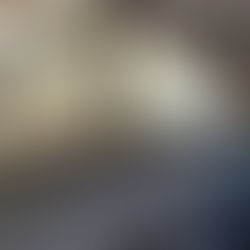Residue & Restoration
- Olivia Peake
- Dec 8, 2016
- 3 min read
Taking to the woodlands with two big blue IKEA bags, I went in search for some discarded old wood to experiment with. As much as I would have loved to work on a scale as large as these two tree trunks, I had to be realistic and think more practically in terms of what interventions I could devise.

I treated the wood as I would an unprimed canvas, starting with the priming, and building up layers of geometric compositions that would (hopefully!) create depth and differences in tone when painting.
It became a type of recycling and up-cycling of the land, and morphing these pieces of wood which would have otherwise been left to rot back into the earth into something new. I was then implementing an artificiality into these natural forms, reflecting the restoration that has been untaken on Dumfries House and estate.
Unfortunately, I wasn't able to take any photos inside Dumfries House itself, but I can do my best to describe some of my favourite highlights of the interiors...
The Library
Feeling like Belle from Beauty and The Beast, stepping into this library was truly enchanting, with column partitions and blind moorish arches, the room was bursting with vintage books piled high against the walls leading to a lowered interior floor underneath a large decorative skylight. After once being the servants quarters, to then being transformed into Scotland's first Turkish Bath room in the 1800s, architect Robert Weir-Shultz reconstructed the room once more to the practical uses of both a library and billiard room. Many remnants of its future history still stand and it's restoration has been beautifully preserved as well as revitalised.
The Family bedroom
Containing the most expensive and extravagant furniture throughout the House, The Family Bedroom was the epitome of luxury. Being cautious of my usual clumsiness, this room treasured such fragility and elegant style- I started to become very conscious of the dry mud in the grooves of my shoes! The Thomas Chippendale four-posted bed took centrepiece to the room with its hand carved mahogany frame covered in damask silk, which in recent years has been arduously restored to its original design from 1759. The incredibly intricate rococo designs of the Axminster carpet also could not be ignored. The prominent golds and pinks inject bursts of lively colour to the room, opposing to its age and over 200 years of use. But aside from all the elaborate furnishings, the innovative uses of digital printed eyemats that were lay to protect the original floor were some of my favourites!
The Pewter Corridor
One of the greatest examples of restoration was The Pewter Corridor which links the west stair and the Blue Drawing Room. Inspired by Byzantine architecture the corridor consists of eight domes connected with curved archways. After new owners painted over the original Robert Adam design, painter Mark Nevin spent tedious amounts of hours carefully scraping away the overcoat of paint to reveal the intricate polychrome decoration. Unfortunately these designs were only restored from one of the domes, but through careful application, the remaining domes were painted in imitation of its original design.
For images of these beautifully restored 18th Century interior designs please visit Dumfries House website....HERE!
So with this fresh in mind, I went about doing my own form of restoration!
The processes of working on natural found wood wasn't easy, it was almost as if the wood was battling against me, refusing to be changed from what it simply is. Splinters, cuts, scratches, etc. The priming, however, worked surprisingly well, I had my doubts whether the paint would simply sink straight into the wood and lose vibrancy. It was interesting that through sanding and trying to perfect these pieces of wood as a surface to paint on, I was making conflicts with the natural aesthetics and characteristics of its material. It made me question whether I was seeking a harmony between the organic and man-made/nature and architecture or highlighting its conflicts.
In response to this I then began returning my wood paintings back to the original place I found them...

I found myself retuning again to the same fundamental processes deeply rooted in my practice. This continuous flux of re-imagining and re-inventing; giving these historic and discarded fragments of wood a new purpose of something mysterious and something becoming. Almost like an after life.




































Comments